|
The Middle Ages
|
|
I. The Early Middle Ages
A. Germanic tribes
1. Germanic literature: Beowulf
2. Germanic art
B. Charlemagne
1. the Holy Roman Empire
2. the Carolingian Renaissance
C. Feudalism
1. Culture of the feudal nobility:
a. the Song of Roland
b. the Bayeux Tapestry
2. Medieval Romance and Courtly Love: Lancelot
D. The Christian Crusades
A. Intellectual movements
1. the medieval universities
2. scholasticism: Abelard, Aquinas
B. Medieval literature
1.Medieval drama: Everyman
|
|
I. The Early Middle Ages
|
|
The Middle Ages
|
|
A. From about 500 to 1350.
B. “The Italian Renaissance humanist Francesco Petrarch (1304-74) coined the term Middle Ages, a time between the
Roman world and the Renaissance.”
C. For Petrarch, the Middle Ages is a time of “Gothic barbarism and intellectual stagnation” (McKay et al. 347).
D. “. . . the Early Middle Ages (ca. 500-1000) was one of the most crative periods in Western history” (Fiero 250).
|
|
A. Germanic Tribes
|
|
A. Germanic invasions
B. Germanic literature: Beowulf.
C. Germanic Art
|
|
Germanic Invasions
|
|
406 Vandals invaded Gaul, Spain, and
North Africa.
410 Rome was sacked by Visigoths.
455 Rome was sacked by Vandals.
476 Western Roman emperor was deposed
by Germanic tribes.
c.500 Anglo-Saxon tribes invaded England.
Early Christian World and the Barbarian Invasions, ca. 500
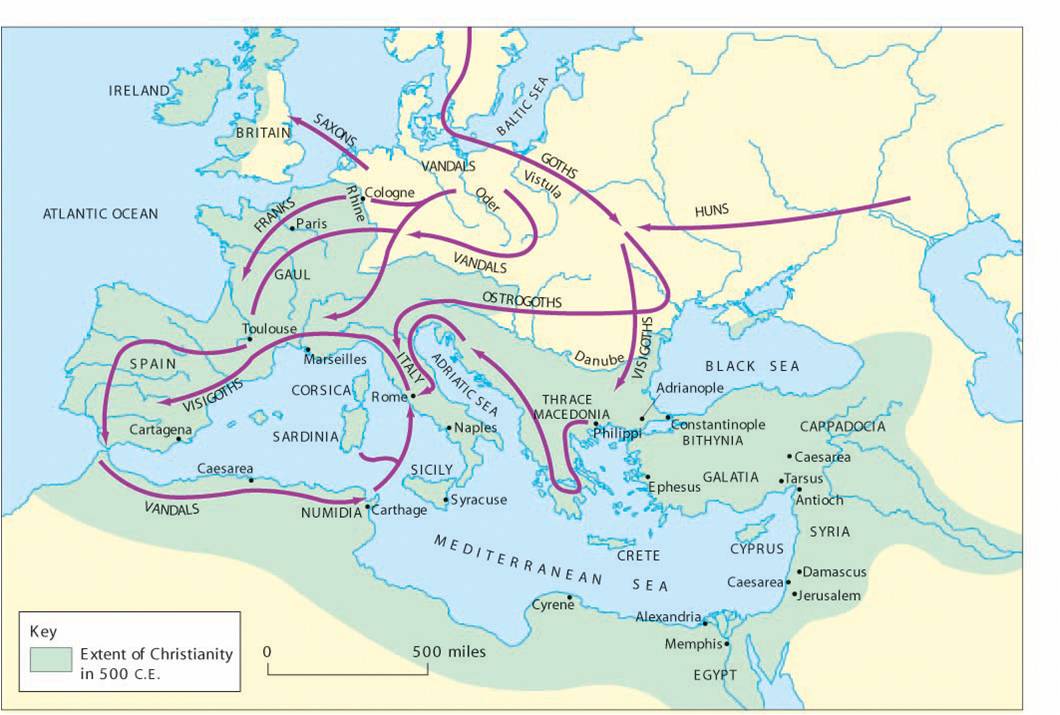
Xplana. Web. 1 Dec 2011.
http://mh1.xplana.com/imagevault/upload/297fd9bf21887234f4ec.jpg
|
|
Impact
|
|
The Germanic conquests accelerated a process of urban decay that was already well advanced.
Values of the Germanic warring culture, such as the bond of fealty, and the practice of rewarding
warriors with land or spoils of battle, would become fundamental to medieval feudalism.
(Fiero 251)
The End of the Western Empire: 476
(After the barbarian king of Italy Odoacer disposed the last Emperor Romulus Augustulus.)
Germanic Kingdoms
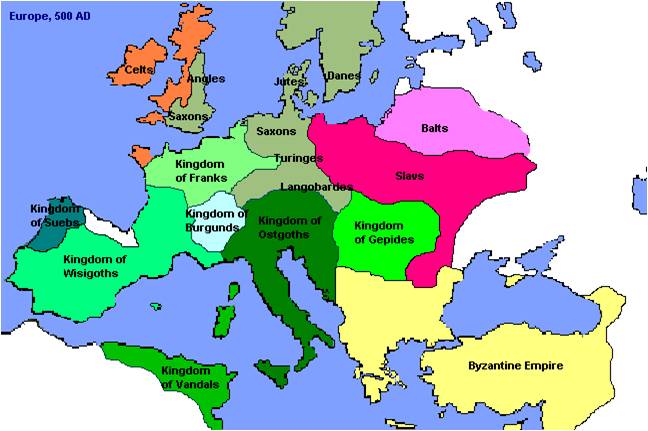
European Heritage Library. Web. 1 Dec 2011.
http://euroheritage.net/italyhistory.shtml
|
|
Germanic Literature
|
|
Beowulf
|
|
About 700; manuscript dating ca. 1000.
Originated among the Anglo-Saxons
Old English
|
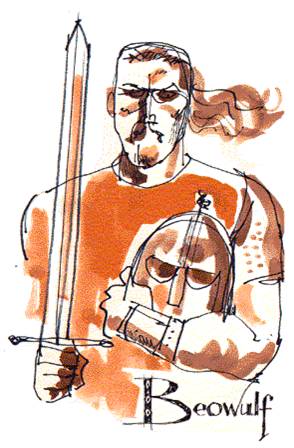
http://www.lone-star.net/literature/beowulf/beowulf2.htm
|
Plot Summary
The hero Beowulf, from a people called the Geats, when a young man visits the Danish court of King Hrothgar and kills in turn two monsters who have savaged the Danish people: first a monster called Grendel, then Grendel''s mother. Fifty years later, as an old man and now king of the Geats, Beowulf kills a dragon which is threatening his own people, but in the process is himself killed.
http://go.galegroup.com/ps/retrieve.do?sgHitCountType=None&sort=RELEVANCE&inPS=true&prodId=LitRC&userGroupName=
866ntu&tabID=T001&searchId=R2&resultListType=RESULT_LIST&contentSegment=&searchType=BasicSearchForm¤tPosition=
3&contentSet=GALE%7CA192258307&&docId=GALE|A192258307&docType=GALE&role=LitRC
|
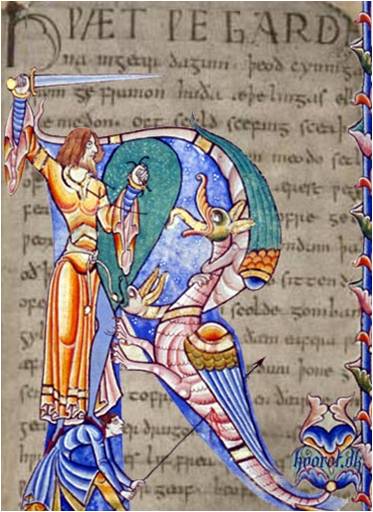
Jnanam. Web. 1 Dec 2011.
http://www.jnanam.net/beowulf_art/beowulf-wiglaf-wyrm-moralia-job-129r[heorot.dk].jpg
|
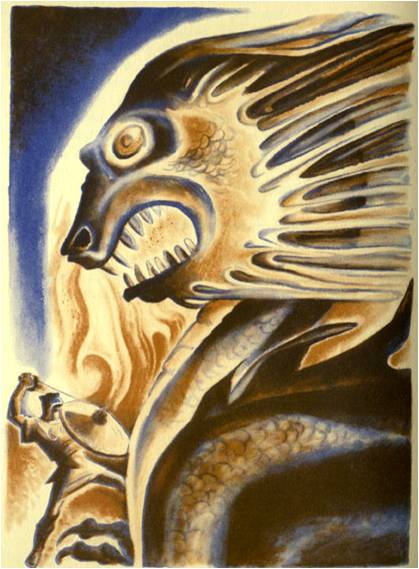
Jnanam. Web. 1 Dec 2011.
http://www.jnanam.net/beowulf_art/lynd%20ward%2018%20%5BBeowulf%20battles%20the%20Wyrm%5D-e.jpg
|
|
|
Germanic Art
|
|
Main features:
Abstract, stylized, decorative
geometric designs
organic, interlaced, intertwined shapes
Horror vacui - literally “fear of empty space”, open spaces in designs are filled
Sutton Hoo, English Purse Lid, c. 650 CE. Cloisonné
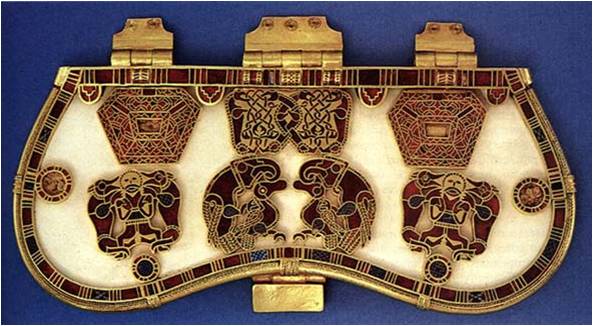
The Slide Projector. Web. 1 Dec 2011.
http://www.theslideprojector.com/art3/art3lecturepresentationssummer/art3lecture21.html
Chi-Rho Page, from the Book of Kells, ca. 800
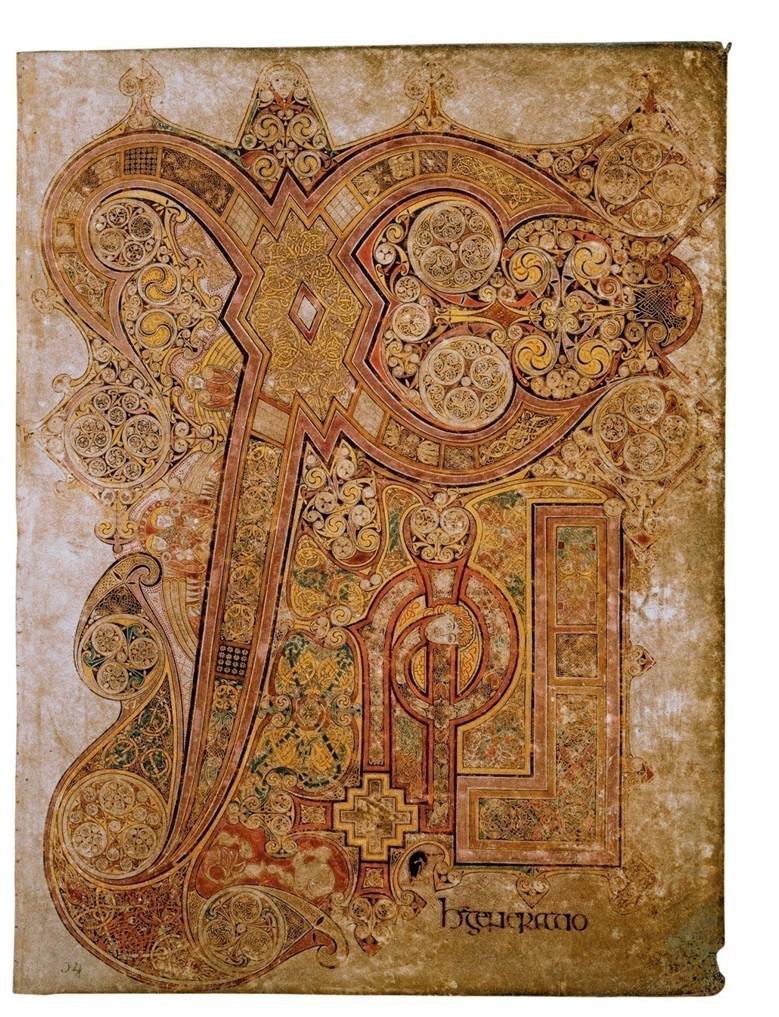
Earlham College. Web. 1 Dec 2011.
http://www.earlham.edu/~vanbma/20th%20century/images/surveydayeightteen.htm
The Lindisfarne Gospels from Northumbria, England, ca. 698-721;
a carpet page, no longer naturalistic as the classical style
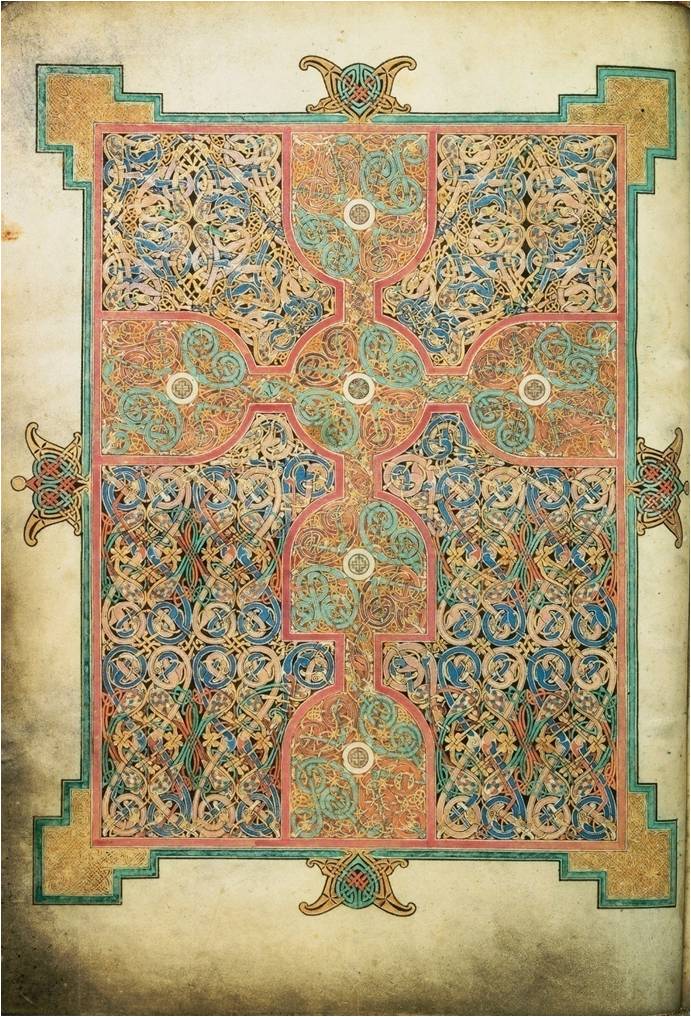
Earlham College. Web. 1 Dec 2011.
http://www.earlham.edu/~vanbma/20th%20century/images/surveydayeightteen.htm
Ardagh Chalice (Eucharistic cup), ca. 800-899
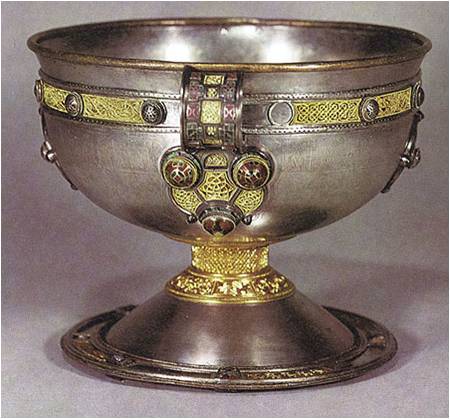
Haverford College. Web. 1 Dec 2011.
http://www.haverford.edu/engl/faculty/Sherman/Irish/ardagh.htm
|
|
B. Charlemagne
|
|
A. Charlemagne and his Empire
B. the Carolingian Renaissance. |
|
1. the Carolingian Empire
717 Clovis (Merovingian): founder of the Frankish State, first Christian king of the Franks
717-751 The Carolingians (Charles Martel and Pepin III) shared power with the Merovingian kings
751 Pepin III became king of the Franks
768 Charlemagne succeeded Pepin III
800 Charlemagne was crowned Holy Roman emperor
843 Treaty of Verdun, the empire was divided into three by Charlemagne’s grandsons
|
|
Charlemagne (768-814)
|
|
Father of France: united the kingdom
Goal of reforms: to revive the Roman Empire
800 crowned by Pope Leo III
Claimed to be the direct heir of Caesar Augustus
Established the “Holy” Roman Empire
|
Equestrian Statuette of Charlemagne,9th century
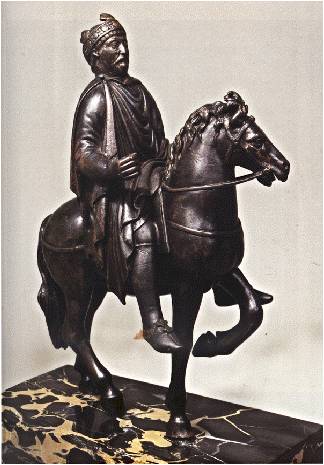
Art History 111. Web. 1 Dec 2011.
https://www.courses.psu.edu/art_h/art_h111_bac18/final.html
|
Equestrian Statue of Marcus Aurelius, ca.161-180
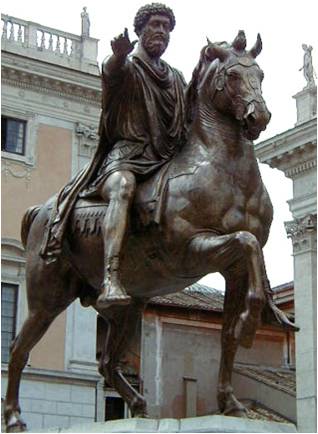
Vroma. Web. 1 Dec 2011.
http://www.vroma.org/images/raia_images/maurelius.jpg
|
|
|
The Carolingian Renaissance
|
|
2. The Carolingian Renaissance
-“Charlemagne” is the French for “Charles the Great.” The Latin form of “Charles” is “Carolus,” hence “Carolingian.”
-viewed classical learning as the foundation of Christian wisdom
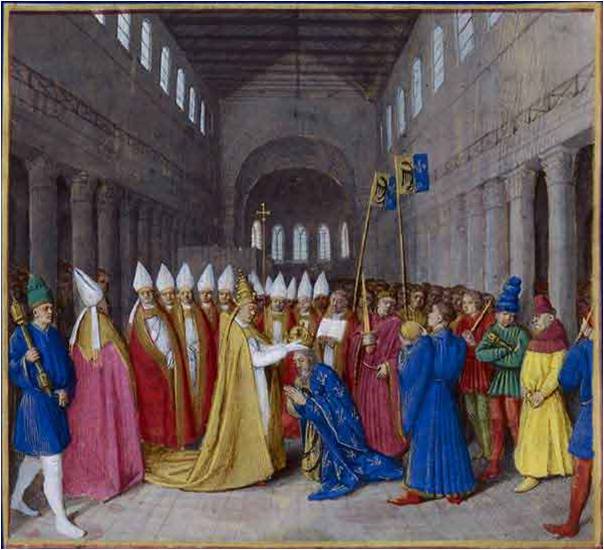
Sheppard Software. Web. 1 Dec 2011.
http://www.sheppardsoftware.com/Europeweb/factfile/Unique-facts-Europe35.htm
The Empire of Charlemagne, 814
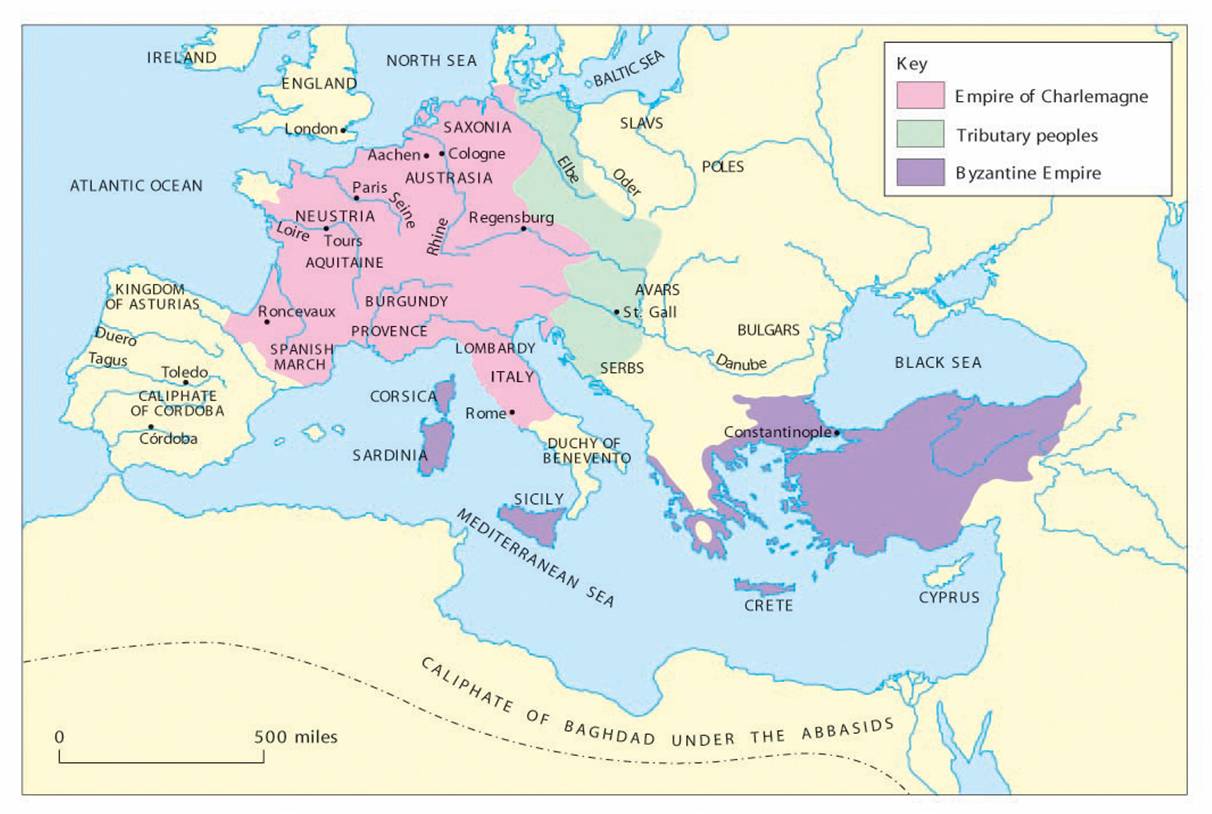
Xplana. Web. 1 Dec 2011.
http://mh1.xplana.com/imagevault/upload/b021ede56f3fd49ead0d.jpg
Charlemagne set up schools at Aachen, in town centers, and in Benedictine monasteries.
The greatest contribution of the Carolingian scholars was not so much the originality of their ideas as their hard work of
salvaging and preserving the thought and writings of the ancients. (McKay et al. 350).
|
Charlemagne’s Church at Aachen, Germany
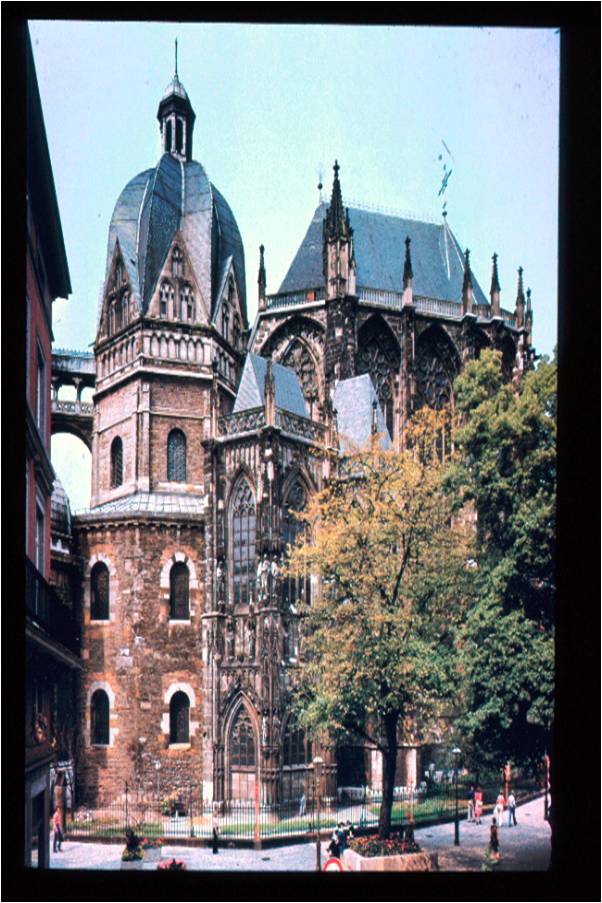
UNCP. Web. 1 Dec 2011.
http://www.uncp.edu/home/rwb/lecture_mid_civ.htm
|
Charlemagne’s Church at Aachen, Germany
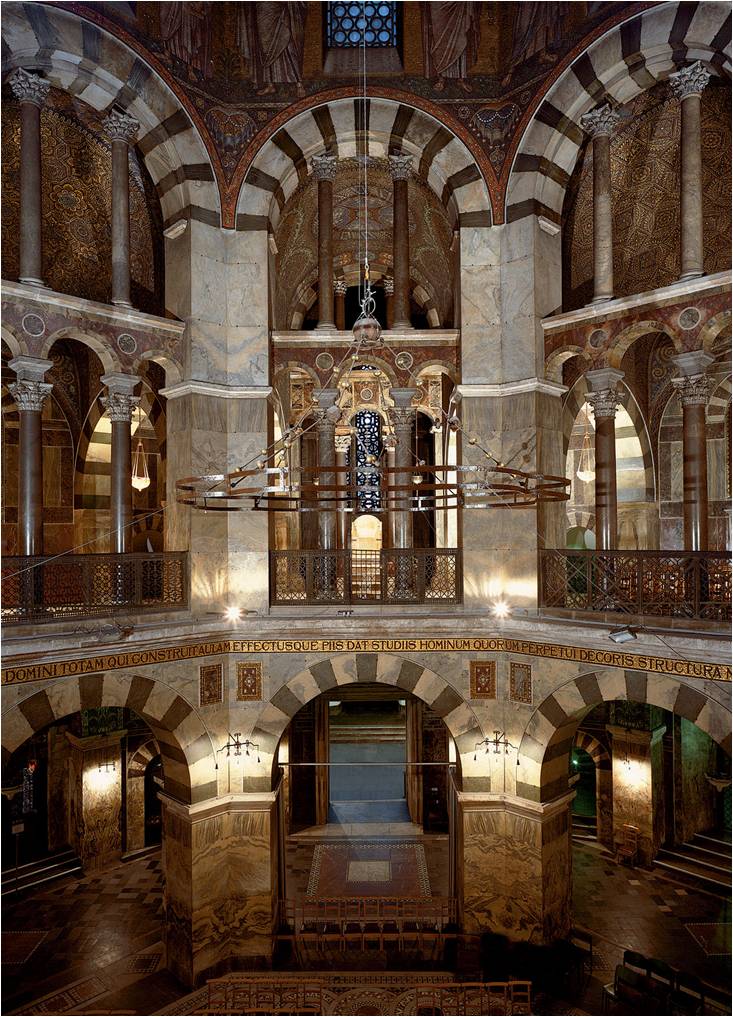
Earlham College. Web. 1 Dec 2011.
http://www.earlham.edu/~vanbma/20th%20century/images/surveydayeightteen.htm
|
St. Matthew, from the Gospel Book of Charlemagne, c.800-10
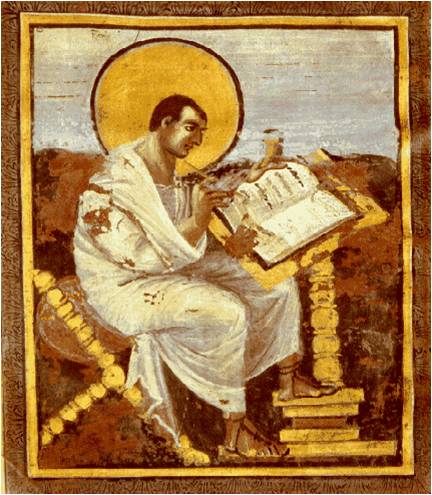
ITS Courses Server. Web. 1 Dec 2011.
https://www.courses.psu.edu/ger/ger100_fgg1/art/romanesque/StMatthewGospel.html
|
Front cover of the Lindau Gospels, ca. 870
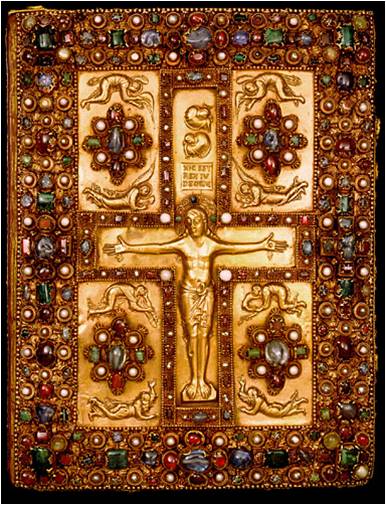
Earlham College. Web. 1 Dec 2011.
http://www.earlham.edu/~vanbma/20th%20century/images/surveydayeightteen.htm
|
Back cover of the Lindau Gospels, ca. 870.
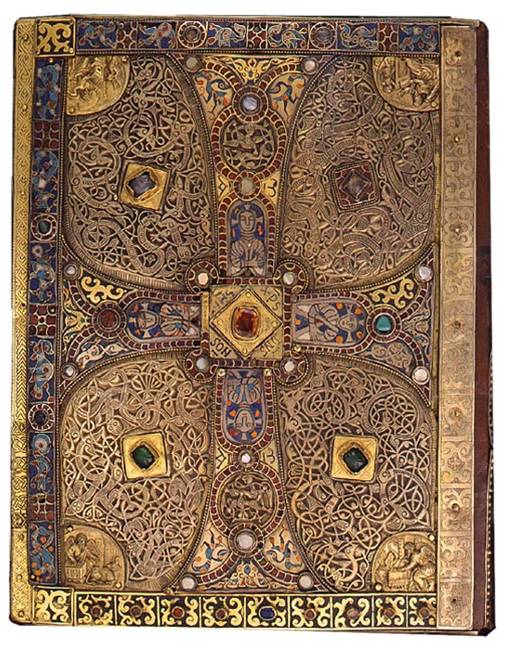
The Morgan Library & Museum. Web. 1 Dec 2011.
http://themorgan.org/collections/collectionsEnlarge.asp?id=67
|
Influence of Byzantine icon
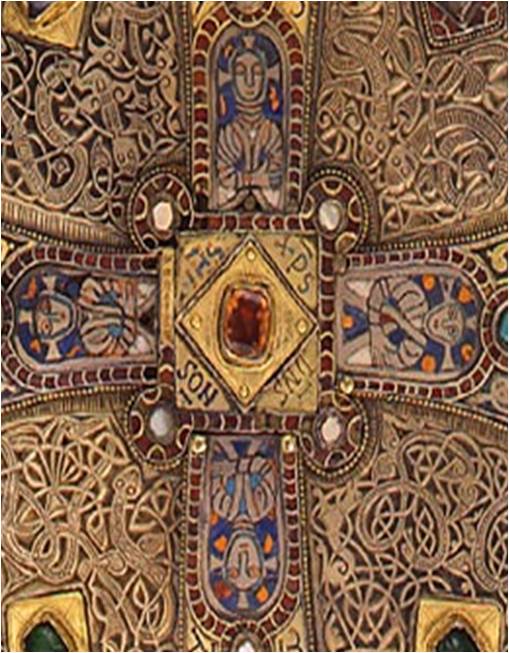
Influence of Roman realism
 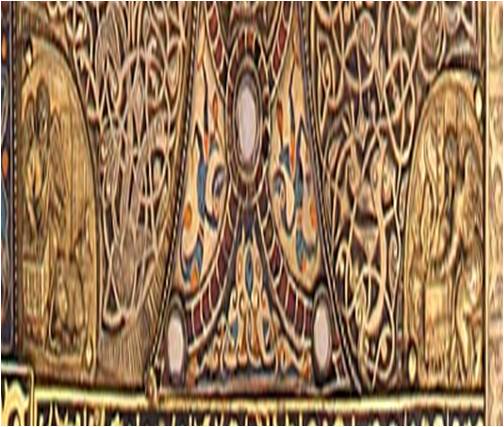 
843 Partitions of Charlemagne’s Empire
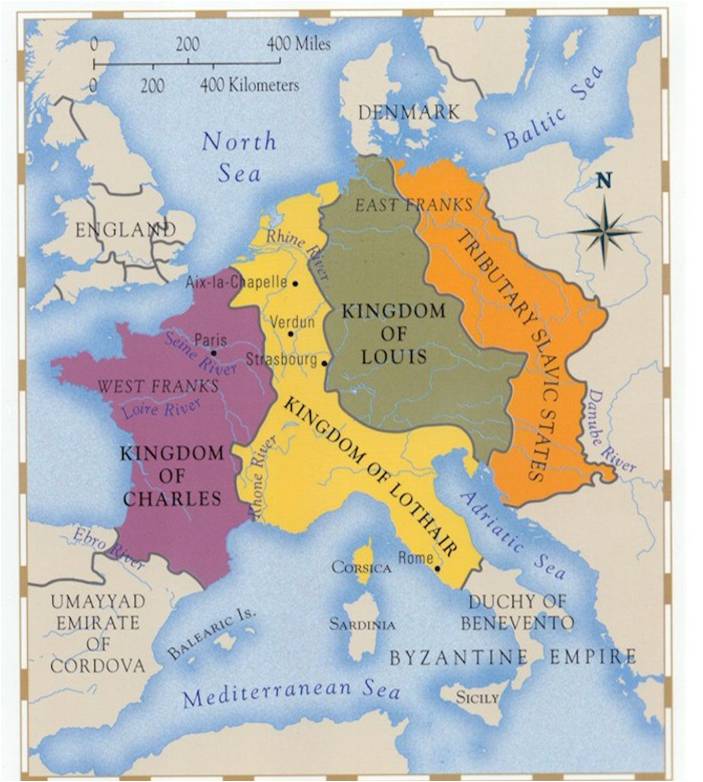
Reading Room (Blog at WordPress.com). Web. 1 Dec 2011.
http://andrewpreslar.wordpress.com/historical-etc/
|
|
C. Feudalism
|
|
A. Definition
B. Culture of the Feudal Nobility:
1. The Song of Roland
2. The Bayeux Tapestry
C. Medieval Romance: Chrétien de Troyes’ Lancelot
1. Chivalry
2. Courtly love
|
|
Feudalism
A term invented in the 17th century and popularized in the 18th century
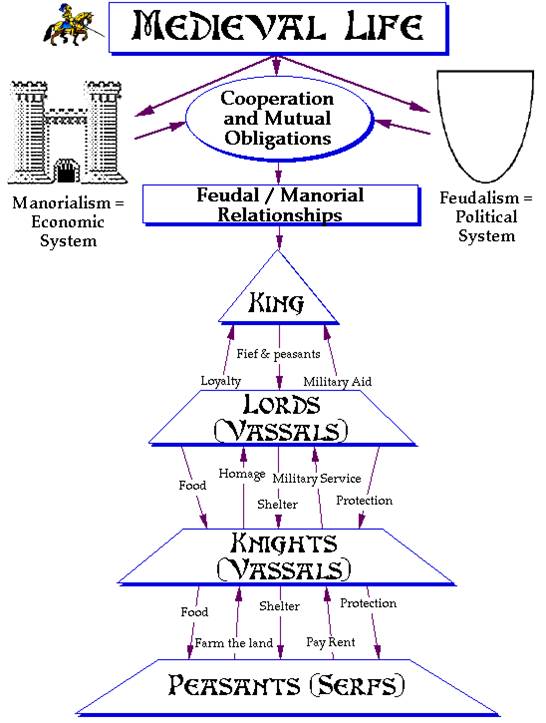
UNCP. Web. 1 Dec 2011.
http://www.uncp.edu/home/rwb/lecture_mid_civ.htm
|
Lord
Male: chevalier, knight
|
Fief |
Vassal |
Serf |
Military Defense
Political
leadership
|
the grant of land (manors) |
Homage and Services to the lord |
Unfree peasants (crops, labor) |
|
|
-King
-Vassals 附庸
Duke 公
Marquis 侯
Earl / Count 伯
Viscount 子
Baron 男
Knight
Squire (a knight’s helper)
-Serfs
|
The rise of medieval towns
→the rise of the middle class
→ the decline of feudalism
1. Culture of the Feudal Nobility
a. The Song of Roland
b. The Bayeux Tapestry
|
|
The Song of Roland
|
|
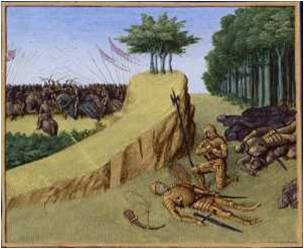
The Free Dictionary. Web. 1 Dec 2011.
http://encyclopedia.thefreedictionary.com/Song+of+Roland
A chanson de geste of Charlemagne’s Spanish campaign in 778.
Structure:
(1) the betrayal of Ganelon, Roland’s stepfather, over a private feud with Roland
(2) the death of Roland, Charlemagne’s nephew and leader of his rear guard
(3) the punishment of the Saracens
(4) the punishment of Ganelon
(Brault xxvii)
Major Themes
Loyalty (1) founded on blood ties
(2) based on feudal ties: mutual obligation between lard and vassal
Controversy regarding Roland as a hero:
(1) a hero that has a tragic flaw (hubris) or commits the sin of pride?
(2) A brave warrior who is a Christ figure that dies for spiritual ideals?
|
|
The Norman Conquest of England in 1066
|
|
The Vikings
|
|
from around 8th to 11th century
Vikings (from Scandinavia)
→ Northmen or Normans
→ Normandy in France
The Vikings: http://www.youtube.com/watch?v=2fc83VvUeE8&NR=1
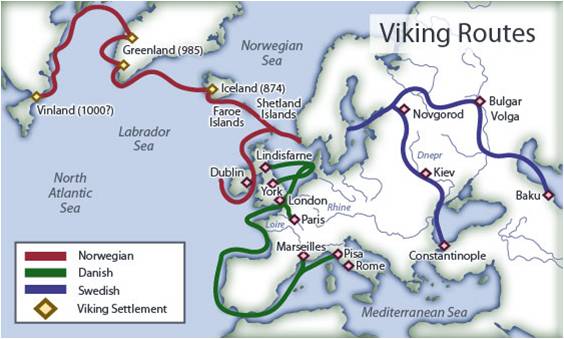
kcdistancelearning. Web. 1 Dec 2011.
http://curriculum.kcdistancelearning.com/courses/AMHISTx-HS-A08/a/unit1/html/section_3_page_4.html
|
|
The Bayeux Tapestry
|
|
The Bayeux Tapestry is history as written by the winners. William of Normandy (in northern France) crosses the English Channel and triumphs at the Battle of Hastings in 1066, becoming William the Conqueror, King of England.
A charge by the Norman Cavalry on the Saxon shield wall.
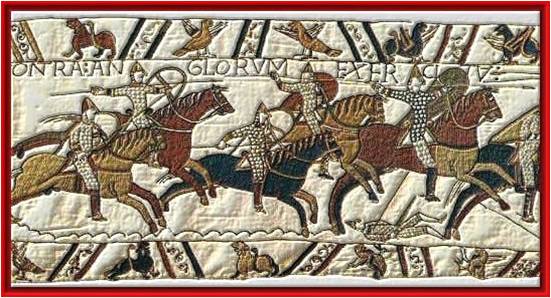
The Battle of Hastings 1066. Web. 1 Dec 2011.
http://www.battle1066.com/btpt4a.shtml
The Saxon shield wall that William and his men found so hard to break down.
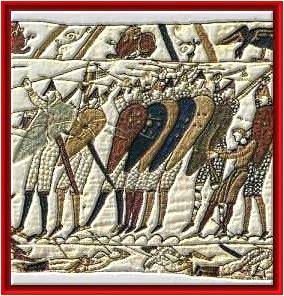
The Battle of Hastings 1066. Web. 1 Dec 2011.
http://www.battle1066.com/btpt4b.shtml
Halley''s Comet, which appeared in 1066, was widely held to be a portent of the disaster that was to befall Harold.
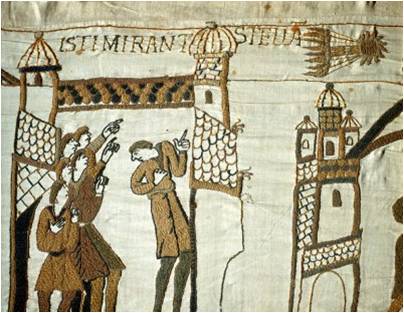
European Space Agency. Web. 1 Dec 2011.
http://www.esa.int/esaSC/SEMXSX57ESD_index_3.html http://sio.midco.net/danstopicalstamps/tapestry.htm
|
|
Consequences
|
|
-The Norman Conquest marked the transfer of power in England from Anglo-Saxon rulers to Norman noblemen who were already vassals of the king of France.
-The Normans brought feudalism to England.
(Fiero 255)
|
|
Medieval Romance and Courtly Love
|
|
“To love was to suffer.” (Fiero 268)
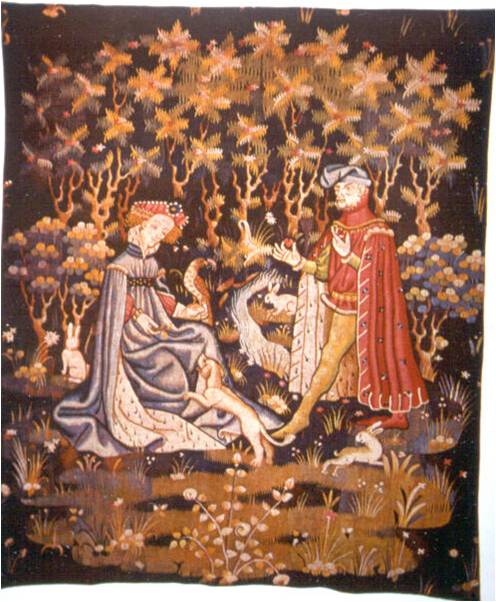
|
|
Chivalry
|
|
an idealization of social, political and personal relationships
Main features:
Knighthood: a bond between men
a form of dedication to God
Between the knight and his sovereign lord: to defend the lands and authority of the king.
Between the knight and the chosen lady who inspired him: He was bound, in all circumstances, to put her interest above his own.
(Lucie-Smith 129)
|
|
Courtly Love
|
|
First embodied in the Arthurian romances
Linked to a shift in religious orientation—the cult of the Virgin Mary
(Lucie-Smith 130)
Love brings pain and suffering, and, at times, even death.
The sufferings of love are closely linked to the difficulties involved in courtship and the ladies who are the principal objects of love are unavailable.
The lover is faithful, obedient and long-suffering. Service is its own reward and no joy is necessarily implied.
A knight’s courage, worship, and prowess that are the masculine equivalents of a lady’s beauty. (McCarthy 51-55)
|
|
Chrétien de Troyes’ Lancelot
|
|
Conflict: Lancelot and Guinevere’s adulterous relationship is one of true love, but it is also a prime factor in the fall of Arthur’s court.
“Lancelot dramatizes the feminization of the chivalric ideal” (Fiero 268).
|
|
D. The Christian Crusades (the 11th – 13th centuries)
|
|
A. Time
B. Causes
C. Major Crusades:
1. the First Crusade
2. the Fourth Crusade
3. the Children Crusade
D. Effects
|
|
The Major Crusades, 1096-1204
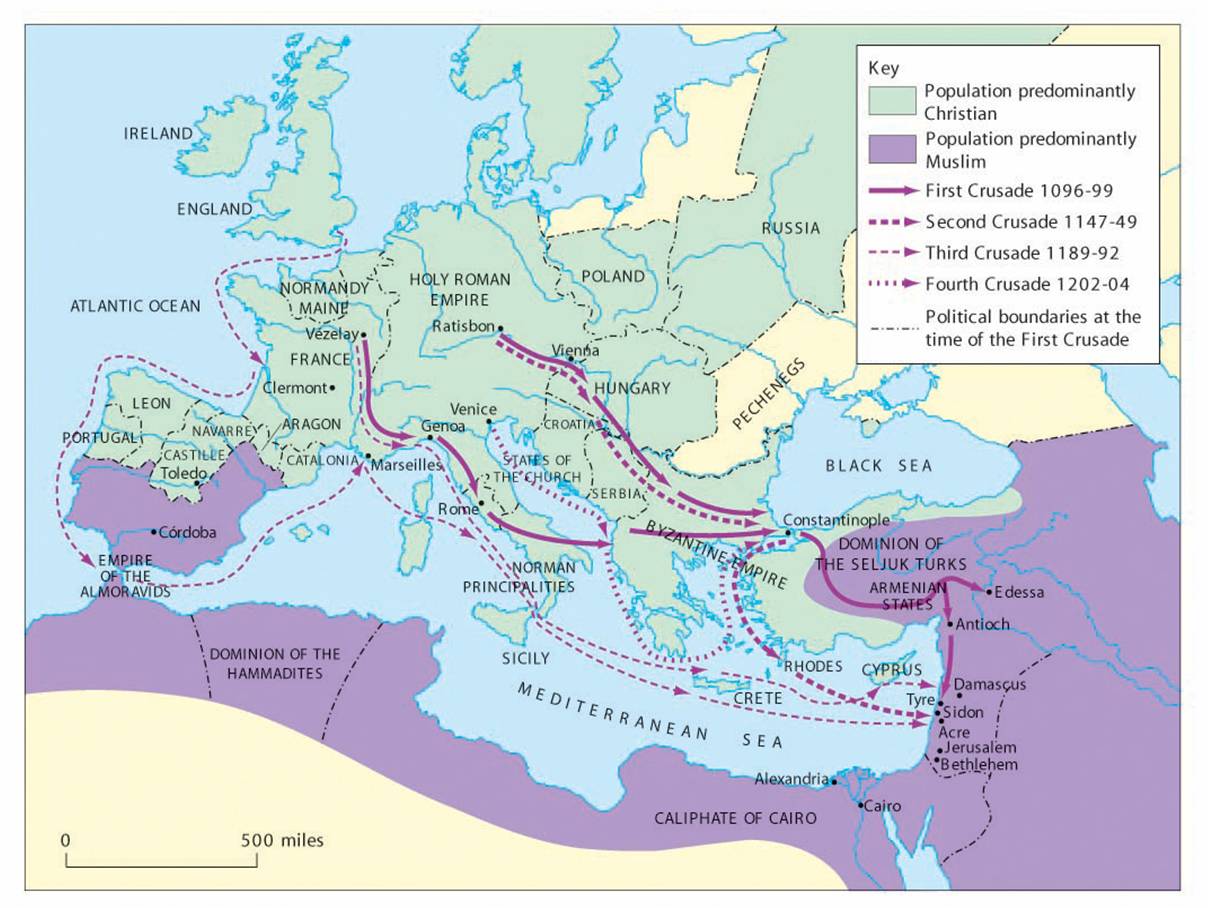
Xplana. Web. 1 Dec 2011.
http://mh1.xplana.com/imagevault/upload/b021ede56f3fd49ead0d.jpg
Causes:
(1) the Seljuk Turks refused to let Christian pilgrims visit the Holy Land
(2) the request of the Byzantine emperor Alexius Comnenus, who hoped to reconquer territory in Asia Minor that had been lost to the Turks (King and Owen 90)
|
|
The First Crusade
|
|
-Mobilized by Pope Urban II in 1095
-Captured Jerusalem in 1099.
-Divided the Holy Land into four kingdoms (Antioch, Edessa, Jerusalem and Tripoli) and ruled for 60 years.
Crusaders persecuting Jews
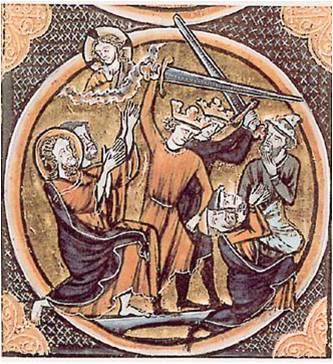
kidipede. Web. 1 Dec 2011.
http://www.historyforkids.org/learn/religion/jews/pictures/firstcrusade.jpg
|
|
The Fourth Crusade (1202-1204)
|
|
The crusaders and the Venetian merchants captured and looted the Christian city of Constantinople.
No attempt was made to free the Holy Land or fight the Muslims.
|
|
The Children’s Crusade (1212)
|
|
A shepherd boy called Stephen led about 30,000 French children on a “crusade.”
The captains of their ships tricked the children by pretending to take them to the Holy Land free. The children were taken
to North Africa and sold to the Muslims as slaves. (Living World History, Vol. II)
|
|
Consequences
|
|
(1) Revival of trade between East and West. (The greatest economic gains went to the Italian maritime republics in of
Venice and Genoa.)
(2) Feudal lords established greater authority, leading to the rise of nation-states.
(3) The crusades promoted cultural exchange between western Europe and the Islamic world. (Arabic translations of
Greek texts and Islamic literature poured into Europe.)
(4) The decline of the Byzantine empire.

|
|
II. The Late Middle Ages
|
|
A. Intellectual movements
|
|
A. Time: the late 12th and early 13th centuries
1. Medieval universities
2. Two systems
3. Seven liberal arts
B. Scholasticism
|
|
Medieval Universities
|
|
-Developed in the late 12th and early 13th centuries along with the emergence of city life.
-The word “universitas” originally meant a guild or corporation.
-Offered advanced studies of law (Bologna), medicine (Salerno), and theology (Paris).
France: University of Paris
Peter Abelard (1079-1142)
Specialized in the liberal arts and theology
Italy: University of Bologna
A leading center of law
England: Oxford and Cambridge
Germany: 1385 Heidelberg
|
|
Two Systems
|
|
A guild of students:
Bologna (Italy, Spain, and southern France)
|
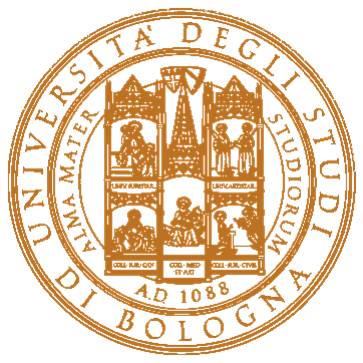 |
|
A guild of teachers:
Paris (northern Europe)
Colleges are semi-independent educational units.
|
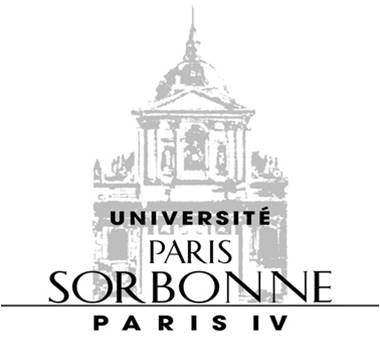 |
|
|
Seven Liberal Arts
|
|
Trivium: grammar, rhetoric, logic
Quadrivium: arithmetic, geometry, astronomy, music
Paris: three philosophies
Natural (physical sciences)
Moral (ethics)
Metaphysical
|
|
Medieval Scholasticism
|
|
Scholasticism
|
|
-The school of philosophy taught by the academics (or schoolmen) of medieval universities circa 1100 - 1500.
-Scholasticism attempted to reconcile the philosophy of the ancient classical philosophers with medieval Christian theology.
http://en.wikipedia.org/wiki/Scholastic
|
|
The Scholastic Method
|
|
Goal: to provide a rational explanation for what was believed on faith
Method:
Questions were raised
Authorities were cited on both sides
The imperative to listen to opposing viewpoints and to engage in dialectical commerce with them.
Summa: 13th century scholastics devoted an enormous amount of time to collecting and organizing knowledge on all
topics. These collections were published as summa, or reference books. (McKay et al. 367)
|
|
Peter Abelard
|
|
1118 seduced a 17-year-old girl, Héloise, who had been taking private lessons with him. The two got married but decided to keep it secret for Abelard’s career. Héloise’s uncle, thinking that Abelard was planning to abandon Heloise, had him castrated. Abelard sought refuge as a monk.
1132-41 Abelard became a teacher. Charged with heresy.
1142 Died in retirement
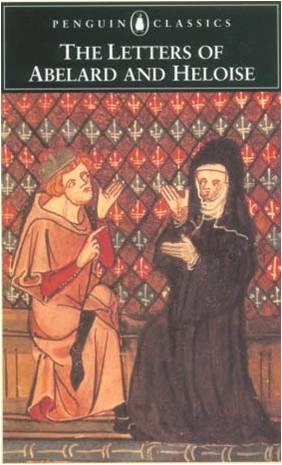
History of ART. Web. 1 Dec 2011.
http://www.all-art.org/literature/history1Abelard1.html
|
|
Sic et Non
|
|
“In short, by doubting we come to questioning; by questioning we perceive the truth” (Sic et Non, Prologue)
“Abelard claimed that it was from doubt, not faith, that one should begin one’s journey to a greater understanding of theology.”
http://wadsworth.com/history_d/special_features/ilrn_legacy/wawc1c01c/content/wciv1/readings/sic_et_non.html
|
|
Thomas Aquinas (1225-1274)
|
|
Thomas Aquinas
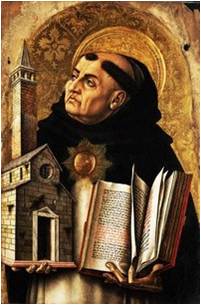
Wikipedia. Web. 1 Dec 2011.
http://en.wikipedia.org/wiki/Thomas_Aquinas
Leading Scholastic theologian of the Univ. of Paris
As a member of the Dominican order, Aquinas was committed to the principle that faith could be defended by reason.
Summa contra Gentiles;
Summa Theologica
Central concern: How does one harmonize those things that are part of human learning (reason) with those supernatural truths revealed by God in the Bible and through the teaching of the church (revelation)?
|
|
Literature
|
|
A. Medieval drama: Everyman
B. Dante: The Divine Comedy
|
|
Everyman
|
|
15th–century
A morality play
A motif: memento mori (Keep death before your eyes!)
Video: http://www.youtube.com/watch?v=Ge07cPl8X48
Morality play
An allegorical drama in which the characters personify moral qualities (such as charity or vice) or abstractions (as death or youth) and in which moral lessons are taught.
Themes
(1) Life is a pilgrimage.
(2) Death is inevitable.
(3) Medieval theology: It is not faith that will save Everyman; his or her willingness to learn (Knowledge), act (Good Deeds), and convert (Confession) will make the difference between salvation and damnation.
|
|
The Divine Comedy by Dante Alighieri
|
|
Dante Alighieri (1265-1321)
|
|
A Florentine deeply influenced by the intellectual currents in Paris.
Exiled from Florence for political reasons in 1300.
The Divine Comedy was written while he was in exile in the north of Italy.
“Comedy”: a happy ending
“Divine”: added later (some say by Boccaccio)
|
|
The First Guide: Virgil
70-19 BCE the Roman poet who wrote The Aeneid, which contains the famous descent of Aeneas into the Underworld in Book VI.
The Second Guide: Beatrice
Beatrice stands for Christian wisdom and blessedness
Dante and Beatrice
First encounter: First met Beatrice when he was nine and fell in love with her at first sight.
Second encounter: Beatrice did not speak to him until nine years later. She greeted him when walking down a street in Florence.
Beatrice married when she was 21, only to die three years after that, at the tender age of 24
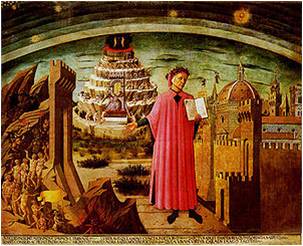
Wikipedia. Web. 1 Dec 20
http://en.wikipedia.org/wiki/Divine_Comedy
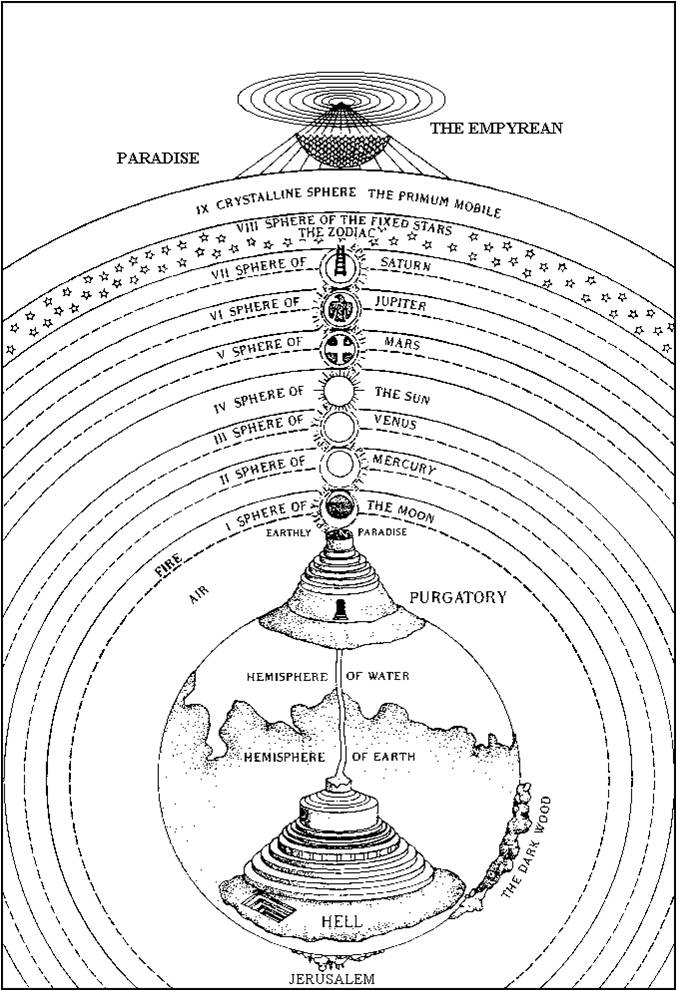
Professor George Rieke. Natural Sciences 102. University of Arizona. Web. 26 Dec 2011.
http://ircamera.as.arizona.edu/NatSci102/images/dante1.gif
Structure
Inferno: Dante travels through the nine levels of hell, starting from the outermost ring, limbo. This ring is inhabited by those who lead blameless lives, but were not baptized. As he progresses to the central circle the sins of the damned become more serious as are their sufferings.
http://cunnan.sca.org.au/wiki/Divine_Comedy
http://www.youtube.com/watch?v=MihXFM24ilA
Circle 1: The virtuous pagans
Circle 2: The lascivious
Circle 3: The gluttonous
Circle 4: The greedy and the wasteful
Circle 5: The wrathful
Circle 6: The heretics
Circle 7: The violent against others, self, God, nature, and art
Circle 8: The fraudulent (10 classes)
Circle 9: The lake of the treacherous against kindred, country, guests, lords and benefactors. Satan is
imprisoned at the center of this frozen lake.
Purgatorio: Dante ascends the seven terraces of Purgatory. Each terrace represents one of the seven deadly sins which must be overcome by the sinner before entering heaven.
http://cunnan.sca.org.au/wiki/Divine_Comedy
http://www.youtube.com/watch?v=LRw1CoKYHvk&feature=related
Ante-Purgatory: the excommunicated, the lazy, the unabsolved, negligent rulers
The Terraces of the Mount of Purgatory
The proud
The envious
The wrathful
The slothful
The avaricious
The gluttonous
The lascivious
The Earthly Paradise
Paradiso: Dante is guided through the nine spheres of heaven, based roughly on Aristotelean cosmology. He then meets God, who grants him the understanding of human nature.
http://cunnan.sca.org.au/wiki/Divine_Comedy
http://www.youtube.com/watch?v=ZaEJr4pix2w&feature=related
The Moon: The faithful who were inconstant
Mercury: Service marred by ambition
Venus: Love marred by lust
The Sun: Wisdom; the theologians
Mars: Courage; the just warriors
Jupiter: Justice; the great rulers
Saturn: Temperance; the contemplatives and mystics
The Fixed Stars: The Church Triumphant
The Primum Mobile: The Order of Angels
The Empyrean Heavens: Angels, Saints, The Virgin, and the Holy Trinity
|
|
Motifs in the Divine Comedy
|
|
Journey: Dante, following Sugar and Aquinas, conceived the human journey as a slow ascent to the purity of God
Light: not mentioned in Inferno. Daylight and sunset symbolize the reception and rejection of divine light. God is a point of light in heaven.
Portraits: character sketches of historical figures and his contemporaries

|
|
Works Cited
|
|
Brault, Gerard J. La Chanson de Roland. Student ed. University Park: Pennsylvania State UP, 1984.
Fiero, Gloria. The Humanistic Tradition. Vol. 1. 6th ed. New York: McGraw-Hill, 2011.
King, Gordon and Frank Owen. Living World History. Vol. 2. Hong Kong: Ling Kee, 1987.
Lucie-Smith, Edward. Art & Civilization. Eaglewood Cliffs, NJ: Prentice Hall, 1992.
McCarthy, Terence. An Introduction to Malory. Suffolk: D. S. Brewer, 1988.
McKay, John P., Bennett D. Hill, John Buckler, Patricia Buckley Ebrey, and Roger B. Beck. A History of World Societies. 7th ed. Vol. 1. Boston: Houghton Mifflin, 2007.
|